How to Build a Homemade Squat Rack
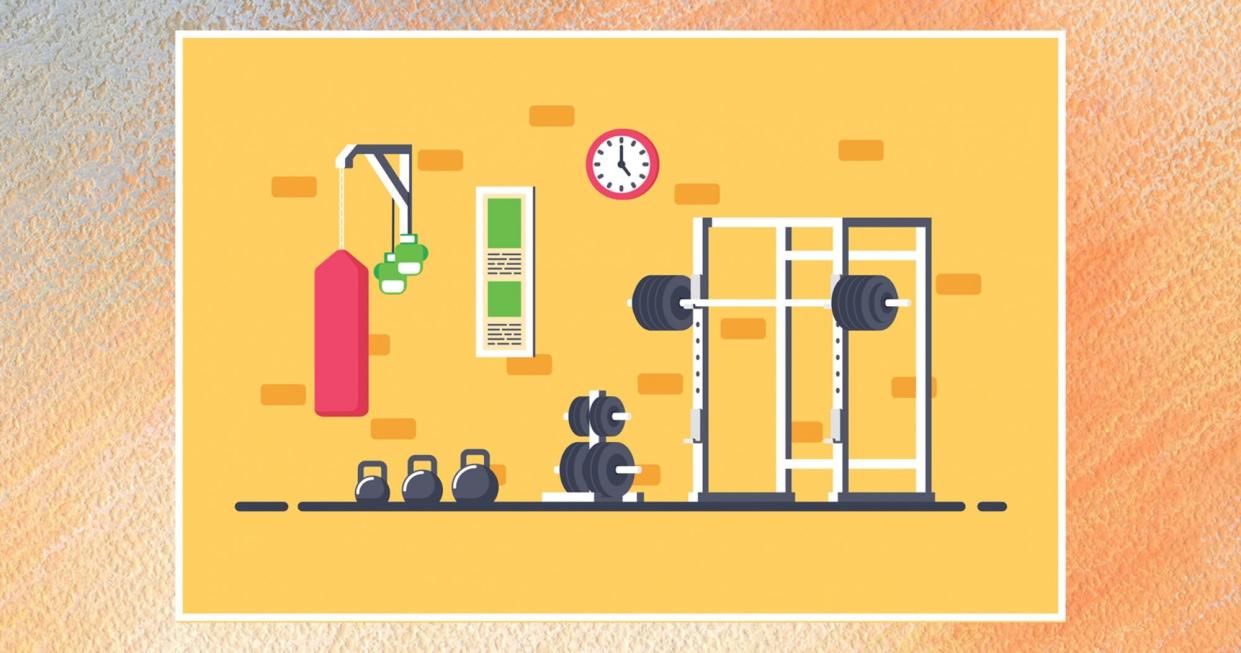
Shai-Halud/Sergey Ryumin/Getty
Before social distancing orders were put into place, access to a barbell, squat rack, weight plates on weight plates on weight plates was a short drive to the gym away. But nearly half a year into the coronavirus pandemic, and most studios and gyms are still closed. Sigh.
So, you may be noodling on ways to finagle some sort of squat stand into your garage, basement, or living room. I'm with you. Just last night, after measuring out the spare space in my bedroom-turned-office, I was furiously googling "homemade squat rack" and "cheap squat rack." Truthfully, the search results were pretty bleak.
That's why I rang up three of my favorite fitness pros for advice on how to build a homemade squat rack, and they had some helpful ideas.
Why Squat Racks Rock
HGTV-ing your own squat rack is no small feat. So if you need a refresher on why building one is worth the work, here's a reminder!
For starters, you can crank out weighted barbell front and back squats (both of which are full-body movements) with the help of a squat rack. "When done with proper form, barbell front and back squats can help you build muscle in your quads, hamstrings, glutes, calves, core, and more," says Brianna Bernard, an Isopure nutrition coach personal trainer. And building muscles has perks like increased muscle mass, reduced body fat, boosted metabolism, and more, says Bernard. Woot! (See more: 11 Major Health Benefits of Lifting Weights)
Plus, squats aren't the only move you can do with a squat stand. Squat racks allow you to easily do other strength movements like barbell lunges, Bulgarian split squats, shoulder press, and more, adds celebrity fitness trainer Oscar Smith, owner and founder of O-D Studio, a personal training gym in New York City.
"If the squat rack allows you to adjust the height of the barbell, you can even do movements like the bench press, inverted barbell row, chin-up, pull-up, and inclined push-up," says Smith.
...But Store-Bought Squat Racks Are Pricey AF
With all the different movement options, there's no doubt: a squat rack is a great investment to make for a home gym. The problem? Even the most streamlined rack will cost you at least a couple hundred dollars. For example, this CAP Barbell Deluxe Power Rack ranges from $220-$440 (Buy It, from $220, amazon.com) depending on color, this Rogue Squat Stand I've been eyeing is $445 (Buy It, $445, roguefitness.com), while more souped-up racks like this Titan Fitness Competition Rack (Buy It, $1,099, walmart.com) rings up at more than a grand.
Not to mention, you'll likely need to invest in a standard 45lb barbell (Buy It, $120, amazon.com), some weight plates (Buy It, from $190, amazon.com), and bar clips (Buy It, $14, amazon.com) too. Yeah, yikes—home gyms don't always come cheap.
And even if the cost isn't a huge factor, "in the middle of a world-wide pandemic, finding in-stock squat racks is even more difficult as tracking down a few rolls of toilet paper," says Bernard. (Raise your hand if you've also been refreshing Rogue's homepage since, like, March? 🙋)
Luckily, a trip to Home Depot or Lowe's and a little creativity is all you need to build a homemade squat rack. "Depending on what you use, it could even cost you as little as $25," says Smith. (Related: Homemade Weights That Will Enhance Your Workout On A Budget)
How to Make a Homemade Squat Rack
When you're ready to get swole and crafty, check out some of the most-popular homemade squat rack ideas below. And remember: "Your safety is of utmost importance, and having a 250-pound barbell on your back is probably not the best time to take big risks, should your squat rack hack malfunction mid-set," says Bernard. So, no matter what, use common sense and *don't* use anything wobbly. Your safety isn't worth a set or five of back squats.
But for the sake of safety, before you try a make-shift squat rack, watch this video about how to properly bail on a back squat. That way, if something does go haywire with your rack you can dump the weight from your back without hurting yourself.
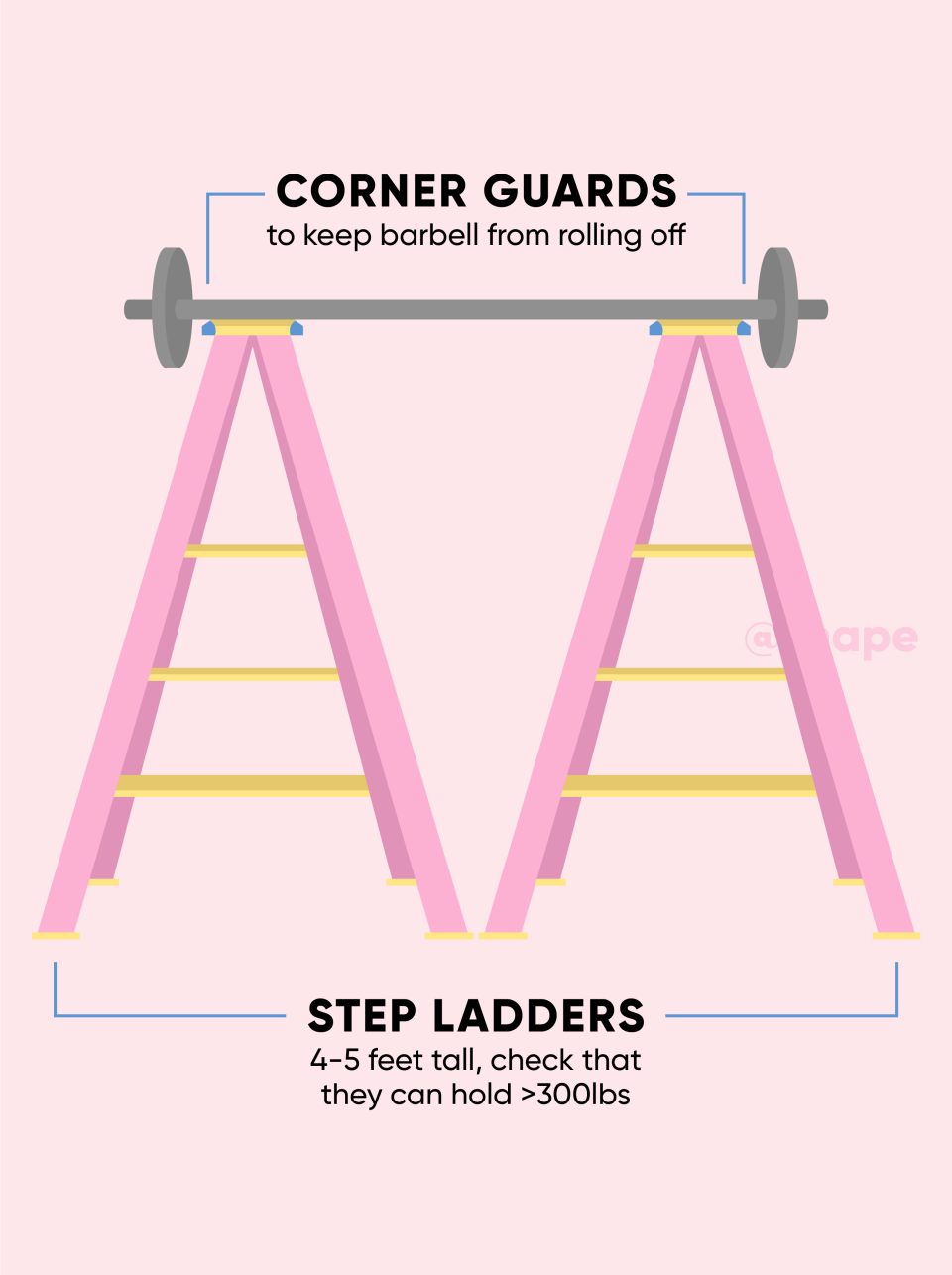
Emma Darvick
1. Homemade Step Ladder Squat Rack
"Take two step ladders, that are about 5 feet high, then plop a barbell on top," says Smith. Easy!
When choosing ladders, the two important factors to keep in mind are height and load. "You want the barbell to be at a height that you can dip underneath the bar, and lift it when you stand up (without getting on your tip-toes)," says Smith. Typically, optimal bar height will be around six to 12 inches shorter than the height of your head. So, if you're 5'8", you're going to want two ladders that are 5ish feet tall like this 5 Foot Louisville Ladder (Buy It, $58, amazon.com). But if you're closer to 5', a ladder closer to 4' like this 4 Foot Louisville Ladder (Buy It, $51, amazon.com) is a better pick.
Before you buy, be sure to peak at the ladder's weight capacity. Most ladders can hold 300 pounds, so unless you're squatting huge weights, there should be no issue. But for the sake of safety, take a peek, K? (Speaking of lifting heavy AF, here's what you need to know about working toward a one-rep max).
Oh, and because the barbell will roll off the ladder unless you're holding it, Smith recommends securing rubber corner-guards to the corners of the top platform. This Roving Cove eight-pack only puts you out $12 bucks (Buy It, $12, amazon.com), but if you have any baby-proofing table-guards hanging around, those should work too.
Total estimated cost: ~$120
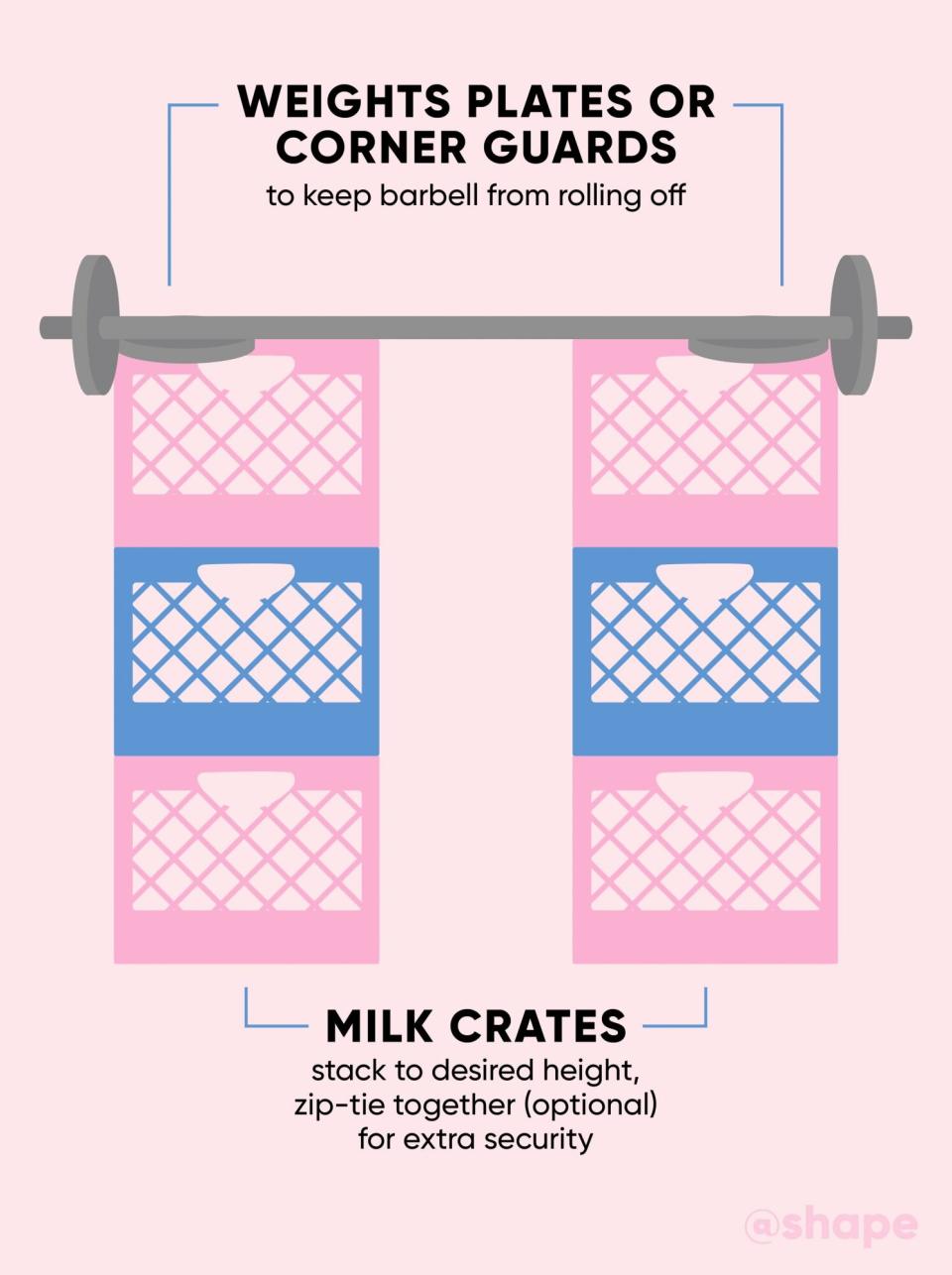
2. Milk Crate Squat Rack
Looking for something you can easily assemble and dismantle? Grab some milk crates—Muscle Rack Black Milk Crate (Buy It, $20 for two, amazon.com)—because when they're not trucking milk, they can be used to hold your barbell. "You can literally just make two stacks of three or four milk crates and sit a barbell between them," says Smith.
While he says these are pretty darn sturdy, you can zip-tie the crates in each stack together for extra reassurance. If you put the open side of the crates pointing up (like this person did), the weight plates on the barbell should be able to nestle right into the opening. If, for whatever reason, you need to flip them over, to keep the bar from rolling off the top of the crates, try using those aforementioned rubber stoppers. Or, take a page from one Redditor's playbook and plop two ten-pound weight plates on top.
Total estimated cost: ~$60
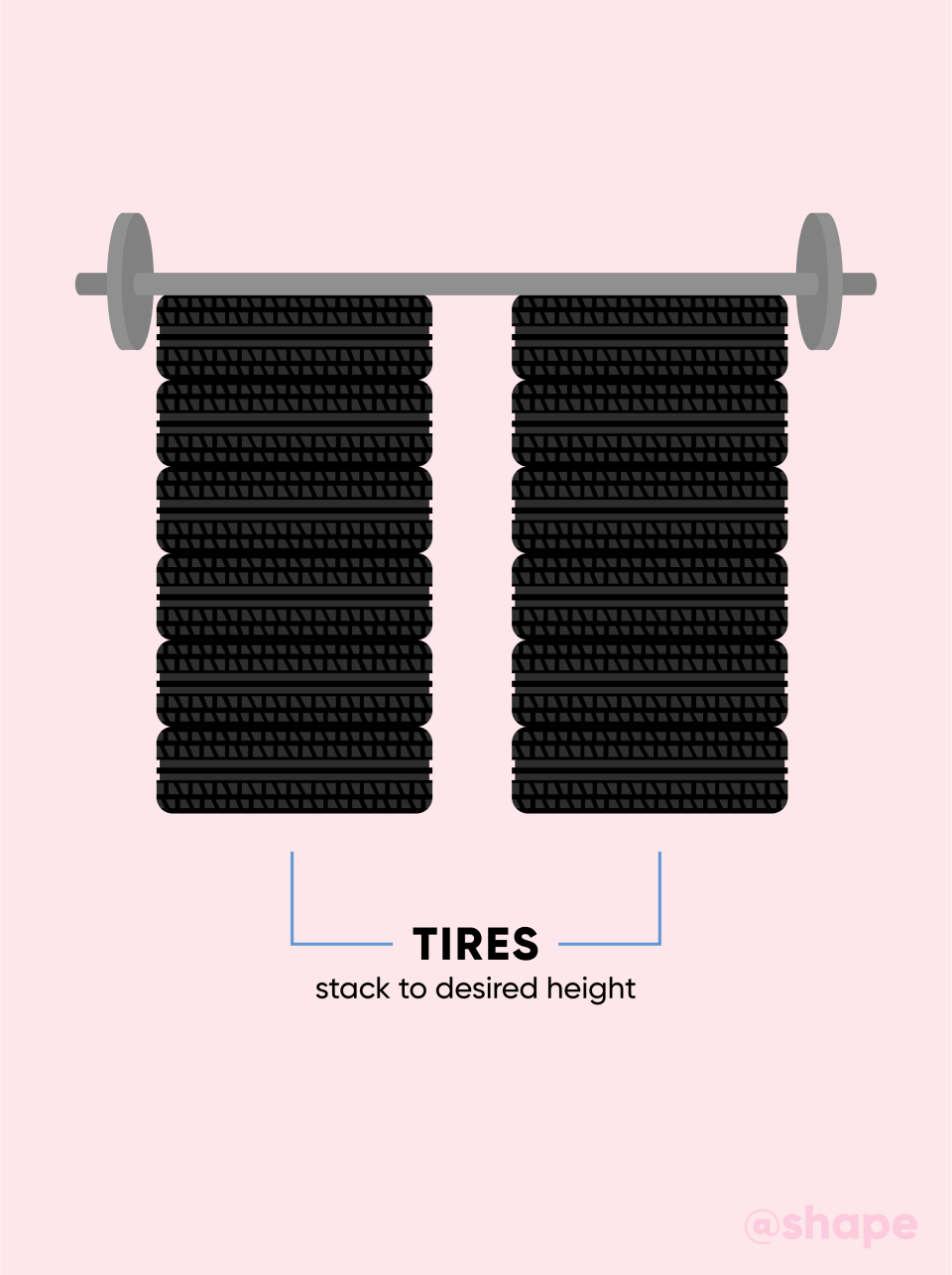
Emma Darvick
3. DIY Tire Squat Rack
If you've got access to a boat-load of tires, stack them! "You might be able to go to a junkyard or your town's tire shop to get old tires for free," says Smith. Truthfully though, if not, this isn't your most cost-effective option. After all, one tire will cost you $20-150 and you'll need at least six. (A bright side: Then you have some tires for flipping, should you want to add that to your workout!)
Total estimated cost: ~$0-160
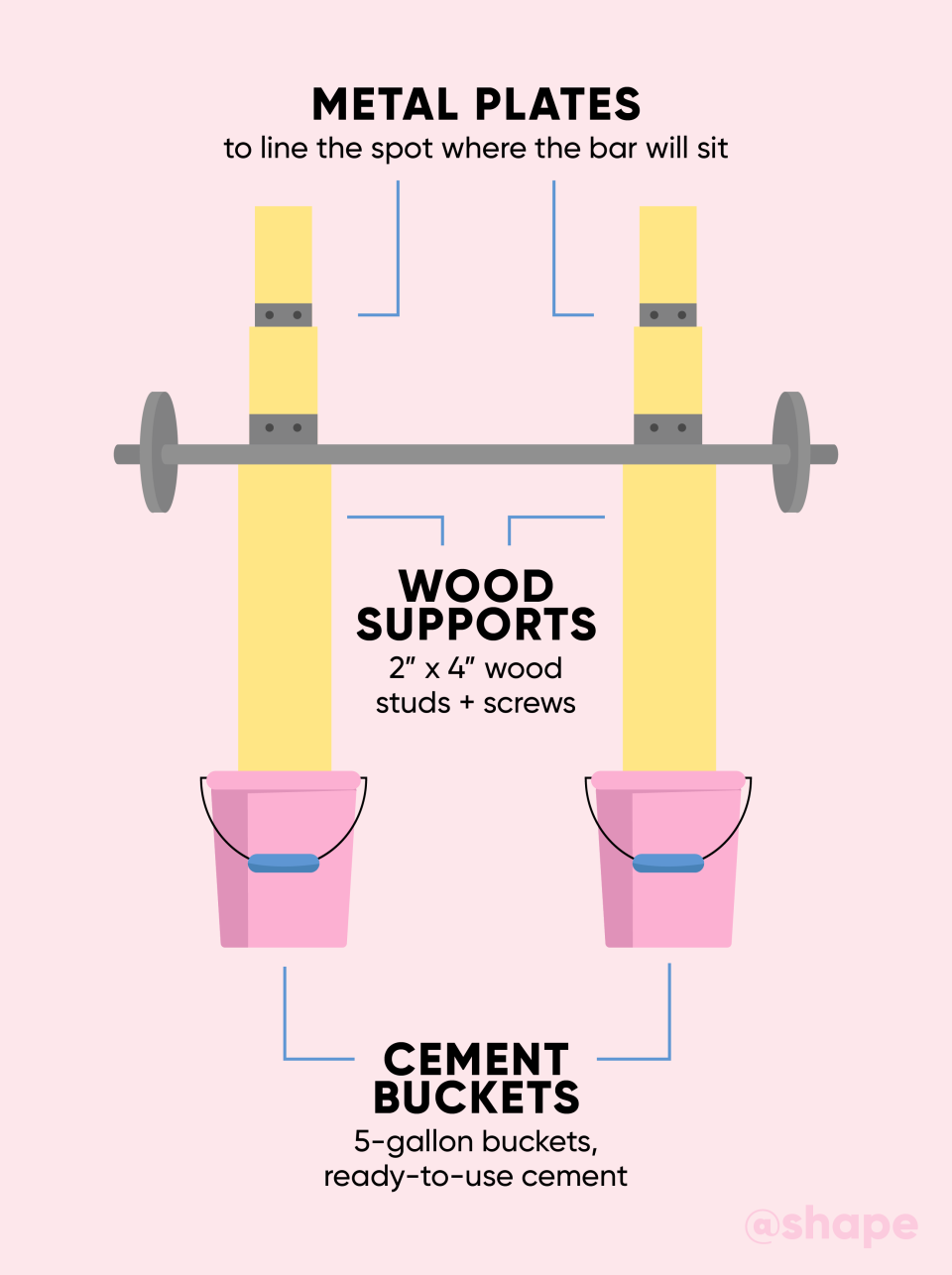
Emma Darvick
4. Wood plans
Are you, like, reallyyy good at putting together Ikea furniture? If so, consider building a squat rack out of wood, nails, and screws. "I have a number of clients who found a building plan online and have hand-crafted beautiful wooden squat racks that are both functional and safe," says Bernard.
You can usually lift pretty damn heavy with these things, too. For instance, "I've used a self-made squat rack out of 4x4's and 2x4's with the ability to squat over 600 pounds and bench over 300 pounds," says CJ Hammond, XPS certified personal trainer with RSP Nutrition. Pretty impressive, right?
The material for a simple DIY like this homemade squat rack or this homemade squat rack will put you out $50 or less. "Just don't leave it in the middle of the middle of the yard where termites exist," says Hammond.
Total estimated cost: ~$50
And If You Don't Have a Squat Rack? Don't Worry, You've Still Got Options!
Not good with a hammer? Don't wanna deal with Home Depot? Can't find a barbell and plates to go with your squat rack? Fear not. It's entirely possible to weight your squats—and do movements like the push-press, bench-press, or weighted lunge—without a rack or barbell. *Whisks away droplets of stress sweat.*
If you already have other weights such as dumbbells, kettlebells, or sandbags on hand, Bernard suggests holding the weight in a goblet position. Doing so will really fire up your glutes and core, she says. If the weights you have are lighter than your usual squat weight, she suggests implementing a 3- to 5-second hold at the bottom of each squat to increase the time under tension and thus boost strength gains. You can also add resistance bands to already-weighted moves to fake the feeling of heavier weights.
If not, it's time to see your house through the lens of a lifter. "Cat litter, mulch, 5-gallon water-bottles, old milk jugs, and bags of flour can all be used to weight movements," says Smith. "You can even just throw a bunch of dirt or mud into a garbage bag, tie it up, and use it as a sandbag." (Watch these trainers use household items as workout equipment for even more inspo.)
No Matter What You Use, Be Safe!
Whether pre-global pandemic you were a strength athlete or not, Smith has a word of advice: "Be careful and use less weight than you think you can use to start." It's common for people to lift too much quickly and to side-line themselves with injury, he says. He recommends using less weight and higher rep schemes (think: 4 sets of 8) for at least two weeks to give your body time to adjust to lifting again.
"You can't go back to that original weight, you have to progress your way up," he says. "But if you're consistent you'll get back there in no time." (Related: What to Know About Training Volume If You're New to Lifting Weights)
On that motivating note, please excuse me—I've got a few things to pick up at Lowe's…

